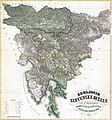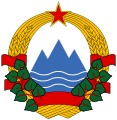Portal:Slovenia
The Slovenia Portal
 |

|
 | |
Slovenia officially the Republic of Slovenia is a country in Central Europe. It borders Italy to the west, Austria to the north, Hungary to the northeast, Croatia to the south and southeast, and a short coastline within the Adriatic Sea to the southwest, which is part of the Mediterranean sea. Slovenia is mostly mountainous and forested, covers 20,271 square kilometres (7,827 sq mi), and has a population of approximately 2.1 million. Slovene is the official language. Slovenia has a predominantly temperate continental climate, with the exception of the Slovene Littoral and the Julian Alps. Ljubljana, the capital and largest city of Slovenia, is geographically situated near the centre of the country. Other larger urban centers are Maribor, Kranj, Celje and Koper.
Slovenia's territory has been part of many different states: the Roman Empire, the Byzantine Empire, the Carolingian Empire, the Holy Roman Empire, the Kingdom of Hungary, the Republic of Venice, the Illyrian Provinces of Napoleon's First French Empire and the Habsburg Empire. In October 1918, the Slovenes co-founded the State of Slovenes, Croats, and Serbs. In December 1918, they merged with the Kingdom of Montenegro and the Kingdom of Serbia into the Kingdom of Yugoslavia. During World War II, Germany, Italy, and Hungary occupied and annexed Slovenia, with a tiny area transferred to the Independent State of Croatia, a newly declared Nazi puppet state. In 1945, it again became part of Yugoslavia. Post-war, Yugoslavia was allied with the Eastern Bloc, but after the Tito–Stalin split of 1948, it never subscribed to the Warsaw Pact, and in 1961 it became one of the founders of the Non-Aligned Movement. In June 1991, Slovenia declared independence from Yugoslavia and became an independent sovereign state. (Full article...)
Selected article -
The olm (German: [ɔlm] ) or proteus (Proteus anguinus) is an aquatic salamander which is the only species in the genus Proteus of the family Proteidae and the only exclusively cave-dwelling chordate species found in Europe; the family's other extant genus is Necturus. In contrast to most amphibians, it is entirely aquatic, eating, sleeping, and breeding underwater. Living in caves found in the Dinaric Alps, it is endemic to the waters that flow underground through the extensive limestone bedrock of the karst of Central and Southeastern Europe in the basin of the Soča River (Italian: Isonzo) near Trieste, Italy, southern Slovenia, southwestern Croatia, and Bosnia and Herzegovina. Introduced populations are found near Vicenza, Italy, and Kranj, Slovenia. It was first mentioned in 1689 by the local naturalist Valvasor in his Glory of the Duchy of Carniola, who reported that, after heavy rains, the olms were washed up from the underground waters and were believed by local people to be a cave dragon's offspring.
This cave salamander is most notable for its adaptations to a life of complete darkness in its underground habitat. The olm's eyes are undeveloped, leaving it blind, while its other senses, particularly those of smell and hearing, are acutely developed. Most populations also lack any pigmentation in their skin. The olm has three toes on its forelimbs, but only two toes on its hind feet. It exhibits neoteny, retaining larval characteristics like external gills into adulthood, like some American amphibians, the axolotl and the mudpuppies (Necturus). (Full article...)
Did you know (auto-generated)

- ... that Slovenian-born singer Ben Dolic was set to represent Germany at Eurovision in 2020?
- ... that after Domen Križaj from Slovenia was a prize winner in the singing competition Neue Stimmen, he moved to the Oper Frankfurt where he appeared as Massenet's Albert and Mozart's Papageno?
Topics
More did you know
- ... that the journalist Johann Georg Reißmüller, a co-publisher of Frankfurter Allgemeine Zeitung, is credited with playing an important part in Germany's recognition of Croatia and Slovenia?
- ... that South Korean businessman Chung Mong-won, an honorary consul of Slovenia, will be inducted into the International Ice Hockey Federation Hall of Fame in 2020?
Related portals
Religions in Slovenia
Ex-Yugoslav countries
Other countries
WikiProjects
Cities and towns
| Rank | Name | Population | Traditional region | ||
|---|---|---|---|---|---|
| 2024 pop. | 2011 pop. | Percentage change | |||
1.
|
288,382
|
272,220
|
Upper and Lower Carniola | ||
2.
|
97,068
|
95,171
|
Styria | ||
3.
|
37,802
|
36,874
|
Upper Carniola | ||
4.
|
37,727
|
37,520
|
Styria | ||
5.
|
26,305
|
24,996
|
Slovene Littoral | ||
6.
|
25,473
|
25,456
|
Styria | ||
7.
|
24,446
|
23,341
|
Lower Carniola | ||
8.
|
18,274
|
18,164
|
Styria | ||
9.
|
13,807
|
13,644
|
Upper Carniola | ||
10.
|
13,778
|
13,440
|
Upper Carniola | ||
11.
|
13,742
|
15,163
|
Styria | ||
12.
|
13,316
|
12,406
|
Upper Carniola | ||
13.
|
13,043
|
13,178
|
Slovene Littoral | ||
14.
|
11,887
|
11,969
|
Upper Carniola | ||
15.
|
11,489
|
11,223
|
Slovene Littoral | ||
16.
|
11,075
|
11,614
|
Prekmurje | ||
17.
|
10,144
|
8,942
|
Inner Carniola | ||
18.
|
10,079
|
9,183
|
Inner Carniola | ||
19.
|
9,125
|
8,413
|
Inner Carniola | ||
20.
|
8,292
|
7,454
|
Styria | ||
21.
|
8,147
|
8,672
|
Lower Carniola | ||
22.
|
7,804
|
7,098
|
Lower Carniola | ||
23.
|
7,651
|
7,519
|
Styria | ||
24.
|
7,253
|
6,112
|
Upper Carniola | ||
25.
|
7,183
|
6,979
|
Carinthia | ||
26.
|
7,072
|
6,656
|
Slovene Littoral | ||
27.
|
6,961
|
6,573
|
Styria | ||
28.
|
6,884
|
7,097
|
Lower Carniola | ||
29.
|
6,710
|
6,467
|
Upper Carniola | ||
30.
|
6,146
|
5,531
|
Slovene Littoral | ||
31.
|
6,099
|
5,940
|
Upper Carniola | ||
32.
|
6,037
|
6,439
|
Upper Carniola | ||
33.
|
5,793
|
5,955
|
Slovene Littoral | ||
34.
|
5,473
|
5,776
|
Lower Carniola | ||
35.
|
5,343
|
5,178
|
Upper Carniola | ||
36.
|
5,233
|
4,869
|
Styria | ||
37.
|
5,202
|
5,181
|
Upper Carniola | ||
38.
|
5,177
|
5,111
|
Styria | ||
39.
|
5,082
|
4,943
|
Styria | ||
40.
|
5,007
|
4,762
|
Styria | ||
41.
|
4,794
|
5,621
|
Styria | ||
42.
|
4,591
|
4,660
|
Styria | ||
43.
|
4,590
|
4,643
|
Carinthia | ||
44.
|
4,352
|
4,553
|
Inner Carniola | ||
45.
|
4,233
|
4,503
|
Styria | ||
46.
|
4,132
|
3,928
|
Inner Carniola | ||
47.
|
3,938
|
3,477
|
Lower Carniola | ||
48.
|
3,821
|
3,865
|
Upper Carniola | ||
49.
|
3,736
|
3,588
|
Upper Carniola | ||
50.
|
3,725
|
3,604
|
Lower Carniola | ||
51.
|
3,671
|
4,192
|
Slovene Littoral | ||
52.
|
3,634
|
3,760
|
Slovene Littoral | ||
53.
|
3,436
|
3,006
|
Styria | ||
54.
|
3,328
|
3,456
|
Styria | ||
55.
|
3,256
|
3,460
|
Styria | ||
56.
|
3,212
|
3,273
|
Lower Carniola | ||
57.
|
3,196
|
3,534
|
Slovene Littoral | ||
58.
|
3,144
|
3,159
|
Styria | ||
59.
|
3,120
|
3,254
|
Carinthia | ||
60.
|
3,063
|
2,935
|
Styria | ||
61.
|
3,052
|
2,880
|
Styria | ||
62.
|
3,051
|
3,289
|
Carinthia | ||
63.
|
2,906
|
3,075
|
Upper Carniola | ||
64.
|
2,818
|
3,129
|
Prekmurje | ||
65.
|
1,937
|
2,168
|
Lower Carniola | ||
66.
|
1,923
|
2,174
|
Styria | ||
67.
|
1,554
|
1,631
|
Slovene Littoral | ||
68.
|
1,192
|
1,000
|
Lower Carniola | ||
69.
|
698
|
695
|
Lower Carniola | ||
- ^ "Population - municipalities and settlements, Slovenia, yearly (in Slovenian)". SURS. Retrieved 15 June 2024.
Categories

Slovenia • Culture • Economy • Education • Environment • Geography • History • Law • Military • People • Politics • Religion • Science and technology • Society • Sport • Tourism • Transport
Associated Wikimedia
The following Wikimedia Foundation sister projects provide more on this subject:
-
Commons
Free media repository -
Wikibooks
Free textbooks and manuals -
Wikidata
Free knowledge base -
Wikinews
Free-content news -
Wikiquote
Collection of quotations -
Wikisource
Free-content library -
Wikispecies
Directory of species -
Wikiversity
Free learning tools -
Wikivoyage
Free travel guide -
Wiktionary
Dictionary and thesaurus











































































































